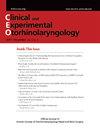Comparative Study of Gasless Transaxillary, Bilateral Axillo-Breast, Unilateral Axillo-Breast With Carbon Dioxide Insufflation, Retroauricular, and Transoral Vestibular Endoscopic Thyroidectomy Approaches at a Single Institution: A Retrospective Analysis and Lessons Learned
IF 2.9
3区 医学
Q1 OTORHINOLARYNGOLOGY
引用次数: 6
Abstract
Objectives This study aimed to present our experiences with various approaches for endoscopic thyroidectomy (ET) and to offer lessons for choosing an approach. Methods The medical records of 701 patients who underwent ET via the transaxillary (TA), bilateral axillo-breast (BABA), unilateral axillo-breast with carbon dioxide insufflation (UABA), retroauricular (RA), or transoral vestibular (TO) approach between May 2008 and March 2020 were retrospectively reviewed. Postoperative pain and cosmetic outcomes were evaluated using visual analog scales. Results The mean operative time of UABA was the shortest among the five approaches (TA, 194.65±51.13 minutes; BABA, 189.11±61.53 minutes; UABA, 118.62±30.23 minutes; RA, 168.22±45.63 minutes; TO, 196.10±40.19 minutes; P=0.02). BABA was the most painful approach, while TO was the least painful on postoperative day 1 (TA, 3.09±0.96; BABA, 3.59±0.92; UABA, 2.39±0.54; RA, 3.49±0.93; TO, 2.01±0.37; P=0.04) and day 3 (TA, 2.10±0.77; BABA, 2.59±0.88; UABA, 1.84±0.37; RA, 3.01±0.67; TO, 1.49±0.45; P=0.04). The TO group had the best cosmetic outcomes at 3 months (TA, 3.91±1.21; BABA, 4.52±1.13; UABA, 4.49±0.74; RA, 4.28±0.74; TO, 4.81±0.48; P=0.04). Conclusion We present a single-surgeon experience of five distinctive ET approaches and the lessons from each approach, together with a literature review. This data may aid endoscopic thyroid surgeons in choosing from various ET approaches.同一机构无气体经腋窝、双侧腋窝-乳房、单侧腋窝-乳房二氧化碳注入、耳后和经口前庭内窥镜甲状腺切除术的比较研究:回顾性分析和经验教训
目的本研究旨在介绍我们对内镜甲状腺切除术(ET)的各种方法的经验,并为选择方法提供经验教训。方法回顾性分析2008年5月至2020年3月期间701例经腋下(TA)、双侧腋乳(BABA)、单侧腋乳二氧化碳吹入(UABA)、耳后(RA)或经口前庭(TO)入路行ET的患者的病历。使用视觉模拟量表评估术后疼痛和美容效果。结果UABA平均手术时间最短(TA 194.65±51.13分钟;BABA 189.11±61.53分钟;UABA 118.62±30.23分钟;RA 168.22±45.63分钟;TO 196.10±40.19分钟;P=0.02),而TO在术后第1天疼痛最小(TA,3.09±0.96;BABA,3.59±0.92;UABA,2.39±0.54;RA,3.49±0.93;TO,2.01±0.37;P=0.04)和第3天(TA,2.10±0.77,BABA,2.59±0.88,UABA,1.84±0.37,RA,3.01±0.67;TO,1.49±0.45;P=0.04 4;TO,4.81±0.48;P=0.04)结论我们介绍了五种不同ET方法的单一外科医生经验以及每种方法的经验教训,并进行了文献综述。这些数据可能有助于内窥镜甲状腺外科医生从各种ET方法中进行选择。
本文章由计算机程序翻译,如有差异,请以英文原文为准。
求助全文
约1分钟内获得全文
求助全文
来源期刊
CiteScore
4.90
自引率
6.70%
发文量
49
审稿时长
6-12 weeks
期刊介绍:
Clinical and Experimental Otorhinolaryngology (Clin Exp Otorhinolaryngol, CEO) is an international peer-reviewed journal on recent developments in diagnosis and treatment of otorhinolaryngology-head and neck surgery and dedicated to the advancement of patient care in ear, nose, throat, head, and neck disorders. This journal publishes original articles relating to both clinical and basic researches, reviews, and clinical trials, encompassing the whole topics of otorhinolaryngology-head and neck surgery.
CEO was first issued in 2008 and this journal is published in English four times (the last day of February, May, August, and November) per year by the Korean Society of Otorhinolaryngology-Head and Neck Surgery. The Journal aims at publishing evidence-based, scientifically written articles from different disciplines of otorhinolaryngology field.
The readership contains clinical/basic research into current practice in otorhinolaryngology, audiology, speech pathology, head and neck oncology, plastic and reconstructive surgery. The readers are otolaryngologists, head and neck surgeons and oncologists, audiologists, and speech pathologists.

 求助内容:
求助内容: 应助结果提醒方式:
应助结果提醒方式:


